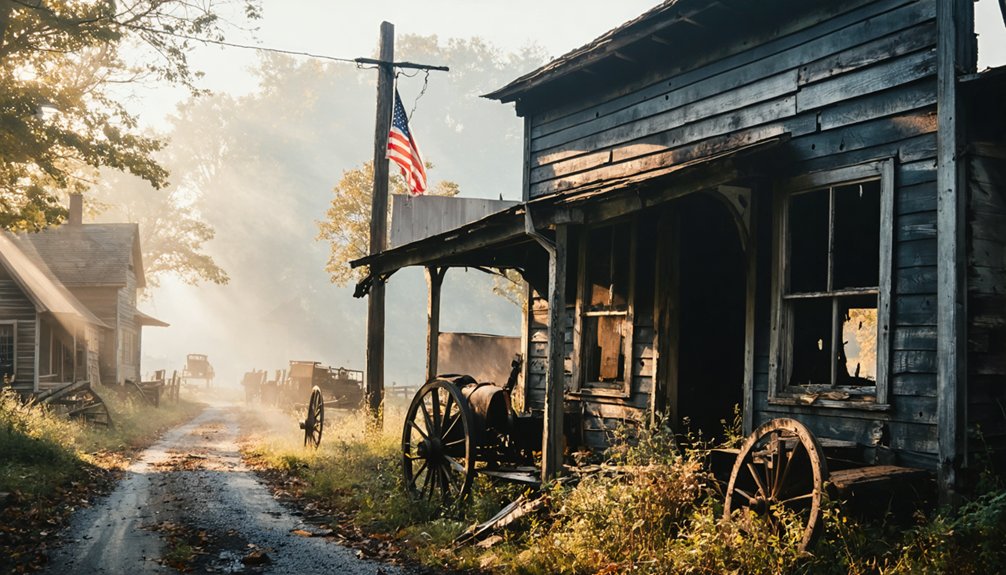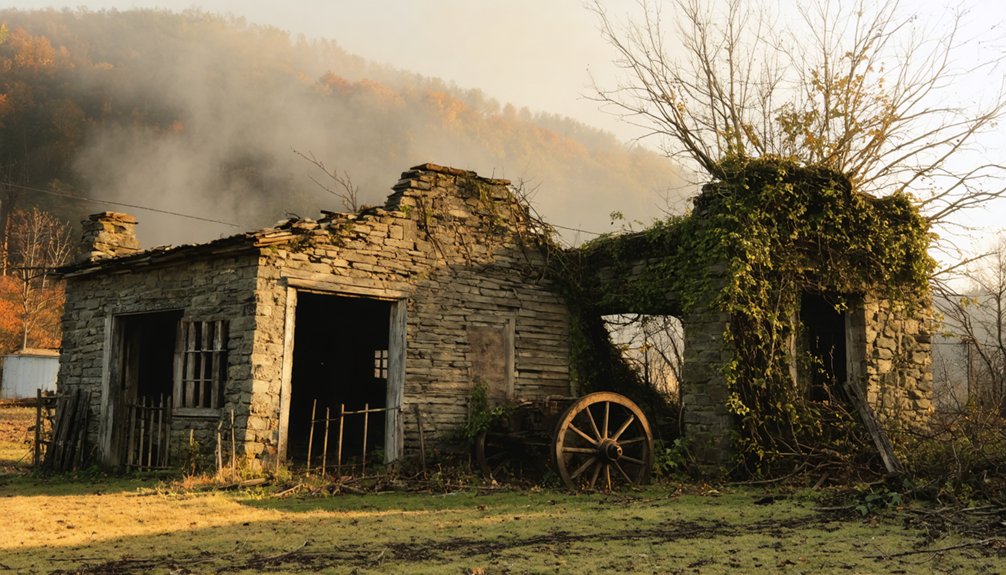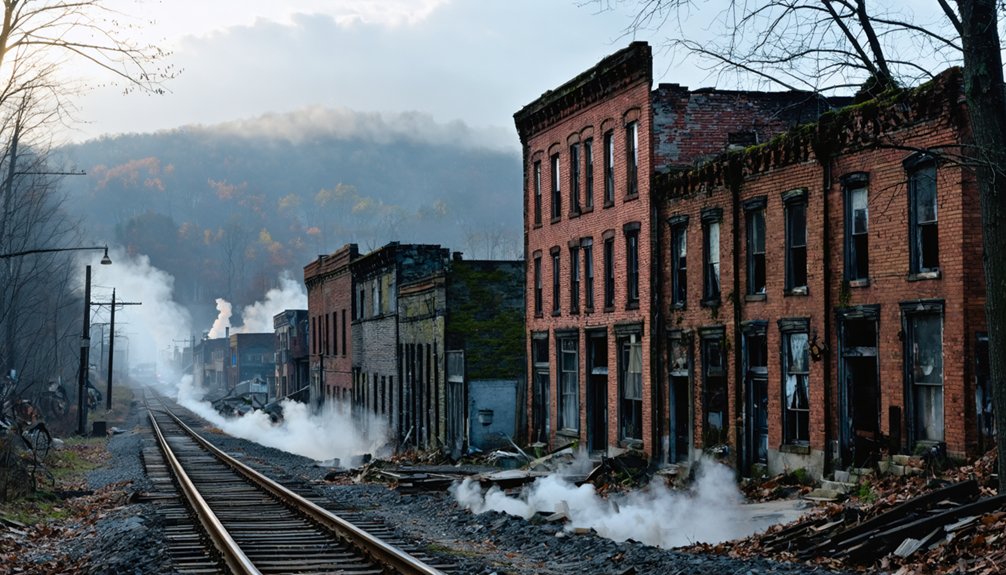You’ll find five haunting Civil War-era ghost towns across America: Cahaba, Alabama’s abandoned capital turned prison; Virginia City, a silver boomtown that financed the Union; Bodie, a lawless frontier settlement known as “a sea of sin”; Elko Tract, a phantom WWII decoy base; and Nuttallburg, a coal mining community shaped by post-war industrialization. These abandoned communities offer a glimpse into America’s turbulent past, each telling its own tale of prosperity, conflict, and eventual decline.
Key Takeaways
- Cahaba transformed from Alabama’s first capital to a Confederate prison before becoming a freedmen’s community and eventually abandoned.
- Virginia City’s silver-rich Comstock Lode financed Union efforts during the Civil War before declining after an 1875 fire.
- Bodie emerged as a lawless frontier town with 10,000 residents and 65 saloons following post-war migration.
- Elko Tract was constructed as a phantom decoy military base during WWII, creating an eerie abandoned settlement.
- Nuttallburg’s coal mining operations flourished after the Civil War before closing in 1958, leaving industrial ruins in Appalachia.
Cahaba: Alabama’s Abandoned First Capital and Union Prison
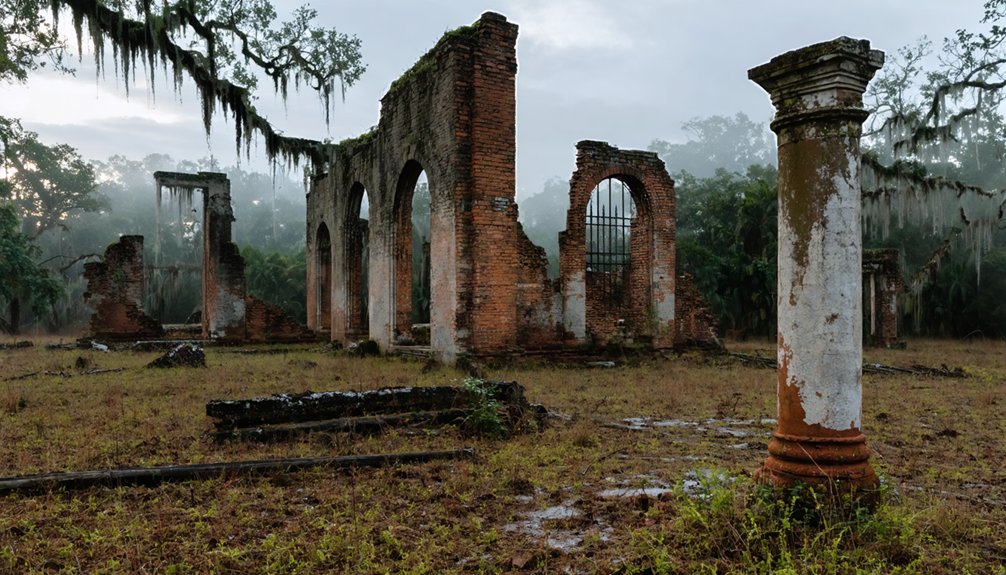
Whispers of political ambition and subsequent abandonment echo through the remains of Cahaba, Alabama’s first permanent state capital established in 1818.
You’ll find this ghost town at the confluence of the Alabama and Cahaba Rivers, where Governor William Wyatt Bibb’s vision briefly flourished until 1825.
Cahaba’s history pivoted dramatically during the Civil War when a cotton warehouse became Castle Morgan, a notorious Confederate prison holding Union soldiers in squalid, lice-infested conditions.
By 1865, flooding compounded prisoners’ suffering as General Forrest negotiated exchanges with Union forces.
After the war, Cahaba transformed into a freedmen’s community—a “Mecca of the Radical Republican Party“—before declining precipitously. Many former slaves achieved landownership and office during this brief period of political empowerment.
Visitors seeking information about Cahaba should be aware that the name refers to multiple subjects and may require clarification when researching its history.
With its courthouse relocated to Selma in 1866 and population dwindling from 3,000 to mere hundreds, nature and neglect reclaimed Alabama’s ambitious first capital.
Virginia City: From Civil War Prosperity to Silver Rush Ghost Town
While the Civil War tore the nation apart, Virginia City, Nevada emerged as a boomtown that would profoundly impact Union war finances. Incorporated in 1861 just before Nevada Territory formed, this silver mining community quickly swelled to 15,000 residents after the 1859 discovery of the Comstock Lode.
You’ll find Virginia City’s legacy etched in American history—its $400 million in precious metals helped finance Lincoln’s Union armies, earning Nevada its “Battle Born” nickname.
The town’s wild character, with shootings and lawlessness above ground matching the intensity of mining below, now fuels ghost stories that captivate visitors. Despite suffering a catastrophic fire in 1875 that left 8,000 homeless, Virginia City rapidly rebuilt. Samuel Clemens, later known as Mark Twain, documented the chaotic and violent atmosphere through his writings while living in Virginia City.
The mining conditions were extremely dangerous, with approximately 300 miners killed during operations in the Comstock.
Today, this preserved frontier town stands as a symbol of how western mineral wealth helped preserve the nation during its darkest hour.
Bodie: the Lawless Frontier Town Born From Post-War Migration
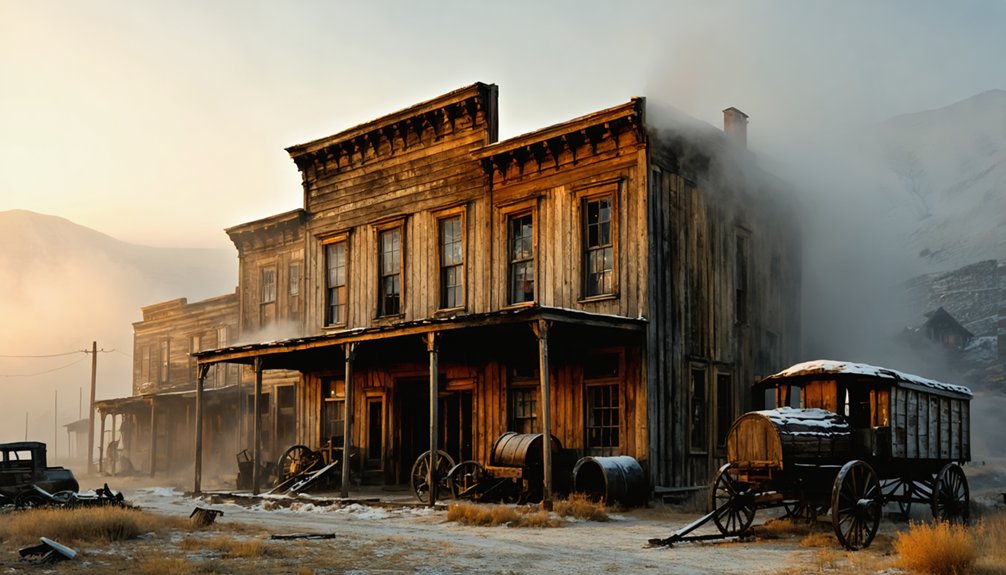
As Virginia City fueled Union war efforts, another mining settlement was taking shape 200 miles southwest in California’s Eastern Sierra. Founded in 1859 when W.S. Bodey discovered gold, Bodie emerged as the quintessential gold rush town—though its founder never lived to see it flourish, perishing in a snowstorm that same year.
Bodie’s explosive growth didn’t occur until 1876 when the Standard Mining Company struck a lucrative deposit. By 1879, nearly 10,000 people inhabited this boomtown where frontier justice prevailed. The term requires disambiguation as it refers to multiple places and people beyond this historic California ghost town.
With over 65 saloons lining its streets, gambling halls, brothels, and opium dens, Reverend Warrington aptly described Bodie as “a sea of sin, lashed by tempests of lust and passion.”
The town’s notorious lawlessness featured frequent shootings and brawls before declining after 1912 and ultimately becoming California’s most authentic ghost town. At its peak, the town’s mines produced an estimated $90-$100 million in precious metals.
Elko Tract: The Phantom Decoy Base That Never Truly Existed
Among the most intriguing deception operations of World War II, the Elko Tract stands as a remarkable demonstration to military ingenuity. Built in 1942-1943, this phantom airfield spread across 2,400 acres of confiscated Virginia farmland, designed to divert Luftwaffe bombers from Richmond Army Air Base.
You’ll find that soldiers of the 936th Camouflage Battalion constructed an elaborate facade—plywood planes, canvas hangars, and cloth trucks arranged in triangular runways that mimicked operational military installations. Surrounding vegetation was meticulously trimmed into silhouettes resembling P-47 fighter planes to enhance the deception from aerial views. This wartime deception included daily movement of props to simulate base activity, maintaining the illusion of a functioning airfield. The displacement affected over 40 farms whose land was seized for the military project.
Though never tested in combat, Elko Tract’s post-war history reveals attempted development into a segregation-era mental hospital that faced significant opposition. Ultimately, it transformed into today’s White Oak Technology Park.
Nuttallburg: Coal Mining Ruins Shaped by Post-War Industrial Growth

Nestled within the verdant New River Gorge landscape, Nuttallburg emerged as one of the most significant coal mining operations in West Virginia’s industrial history. Established in 1870 by English entrepreneur John Nuttall, this post-Civil War development quickly transformed into a thriving community after the Chesapeake & Ohio Railway‘s 1873 completion.
Nuttallburg’s mining legacy expanded dramatically as its population reached 342 residents by 1890, with 110 company houses stretching along the gorge. The segregated community design placed African American miners at the town’s entry with separate facilities. The town’s specialization in high-carbon smokeless coal attracted Henry Ford, who purchased the operation in 1920 and modernized its infrastructure through his Fordson Coal Company.
This remarkable Nuttallburg heritage represents Appalachia’s industrial boom, where former slaves and immigrants found employment in a rapidly evolving economy that fueled America’s post-war industrial revolution until operations ceased in 1958. The area now sits within the New River Gorge National River, established in 1978 to preserve this historical coal mining connection.
Frequently Asked Questions
Were Ghost Towns Targeted for Strategic Reasons During the Civil War?
Frequently found at frontiers, ghost towns were targeted for strategic reasons during the Civil War. You’ll notice they controlled strategic locations, enabling military logistics and resource acquisition essential for wartime advantage.
What Paranormal Investigation Equipment Works Best in Abandoned Mining Towns?
You’ll find EMF detectors most effective in abandoned mining towns, as they detect electromagnetic fluctuations associated with spirits. Spirit boxes also excel by capturing disembodied voices within these trauma-rich historical environments.
Did Confederate and Union Deserters Hide in These Ghost Towns?
Yes, you’ll find deserters from both armies sought Civil War refuge in ghost towns, using abandoned structures as deserter hiding spots while evading military authorities throughout contested territories.
How Did Post-War Racial Tensions Impact Ghost Town Preservation Efforts?
Empty doorways symbolize selective memory—you’ll find racial dynamics heavily influenced which stories survived. White communities prioritized Confederate legacies while Black heritage sites faced deliberate neglect, creating profound preservation challenges for authentic historical narratives.
Are There Documented Cases of Treasure Still Found in These Towns?
Yes, you’ll find documented treasure hunts have yielded Civil War-era coins, musket balls, and lost artifacts in places like Dent’s Run, Pennsylvania, where the FBI conducted a secretive dig in 2018.
References
- https://www.loveexploring.com/gallerylist/131658/abandoned-in-the-usa-92-places-left-to-rot
- https://www.blueridgeoutdoors.com/go-outside/southern-ghost-towns/
- https://www.mentalfloss.com/geography/american-ghost-towns-can-still-walk-through
- https://www.wideopencountry.com/the-10-eeriest-ghost-towns-in-america/
- https://www.mythfolks.com/haunted-us-ghost-towns
- https://www.christywanders.com/2024/08/top-ghost-towns-for-history-buffs.html
- https://www.visittheusa.com/experience/5-us-ghost-towns-you-must-see
- https://www.geotab.com/ghost-towns/
- https://en.wikipedia.org/wiki/Lists_of_ghost_towns_in_the_United_States
- https://encyclopediaofalabama.org/article/cahaba/
